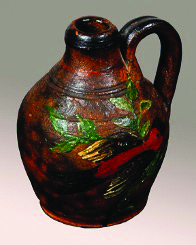

Pottery by the family of Leonard Cain.
Leonard Cain’s family business was pottery. Born of German heritage in North Carolina in 1782, Leonard made his home in Sullivan County, Tennessee, moving there at some point during the second decade of the 19th century. It was here that he raised his family. It is only through family tradition that Leonard was known as a potter, but sons William and Abraham most certainly were. In 1850, the census records actually noted Abraham’s occupation as “potter.” William, like so many potters, called himself a “farmer,” possibly considering their family pottery business a sideline occupation. Their brother, Eli, lived in Wythe County and did acknowledge his occupation as “potter.”
By 1870, William’s son, Martin, had joined the family business as well as the possibility of another son, John, since a jar dated 1876 with the signature J.E. Cain has been found. The Cain family pottery was earthenware, using the good red clay near their homes, which they sealed with lead glazing. They made everything needed for household storage: jars, jugs, crocks, churns, and even flower pots. Some are decorated with wavy or straight lines incised around the neck as well as manganese oxide daubs and dribbles under the glaze. Only a few pieces were signed. Perhaps the latest known piece of Cain pottery is the small jug featured here, which is 5 ¼” high and includes an over-painted bird perched on a branch that was probably added at a later time. On the bottom is the incised inscription, “Made by A.B. Cain / Sept 15, 1897, Sullivan (County?).” Abraham died in 1910 at age 85.
This is the seventh in a new series of articles on Tennessee arts and antiques by Betsy K. White, director of William King Museum of Art, Abingdon, Virginia. She is the author of two books on the history of the region’s decorative arts and material culture: “Great Road Style: The Decorative Arts Legacy of Southwest Virginia & Northeast Tennessee” and “Backcountry Makers: An Artisan History of Southwest Virginia and Northeast Tennessee.”